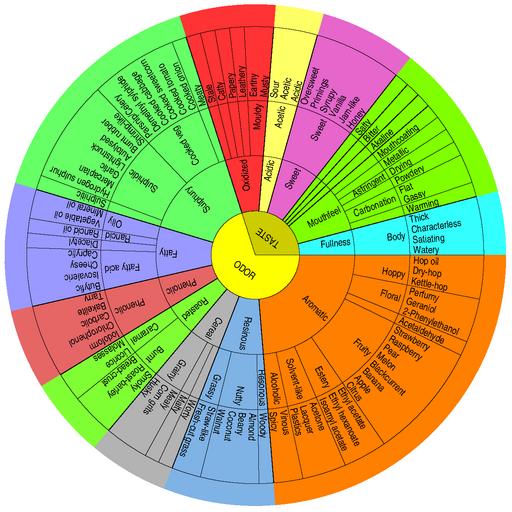MAKE A MEME
View Large Image

| View Original: | Beer_Flavor_Wheel.png (1288x1288) | |||
| Download: | Original | Medium | Small | Thumb |
| Courtesy of: | www.flickr.com | More Like This | ||
| Keywords: organoleptic beer tasting beertasting zymurgy circle round disk In 1979, brewing chemist Morten Meilgaard created the Beer Flavor Wheel to be a standard for beer organoleptic analysis. Soon afterward, the European Brewery Convention, the American Society of Brewing Chemists, and the Master Brewers Association of the Americas all accepted it as such. ****************** "The Meilgaard system developed by Meilgaard in 1975, was the first attempt to link flavor characteristics to certain styles of beer. This classification scheme assigned a Flavor Unit (FU) rating to each flavor constituent, defined as the ratio of a given compound's concentration to its threshold value. Thus, if an American amber ale contained a caramel compound in concentrations twice that of its threshold value, for example, it would have an FU of 2. In this context, the relevant threshold is one of recognition, which corresponds to the lowest physical intensity at which a stimulus is correctly identified. This is to be compared with the stimulus threshold, the lowest physical intensity at which stimulus is perceptible and the difference threshold, the smallest change in physical intensity of a stimulus which is perceptible. In the Meilgaard system, compounds primarily responsible for "beery" flavors are called primary constituents. These have concentrations above 2 FU (therefore they are generally present at concentrations at least twice the threshold). Removing any primary constituents from the beer would have a significant impact on the flavor. It doesn't require much sensory training to recognize the essential contributions of alcohol, hop bitterness (technically), and carbon dioxide to any beer's flavor. Although not as intense, secondary constituents (classified as having 0.5-2.0 FU) constitute the bulk of the flavor and act together to provide the characteristics that distinguish different beer styles. Removal of any of these secondary constituents would result in a lesser but still noticeable change in the flavor. The next group is the tertiary constituents (0.1-0.5 FU) responsible for contributing subsidiary flavor notes. Removal of these, or of any of the background constituents with concentrations below 0.1 FU, produces no perceptible change in beer flavor, though these compounds nevertheless contribute to the overall character of the beer. Just as if you had removed the spices from a casserole, they may not be a major part of the recipe, but without them the end result will be flat." — Scott Bickham An Introduction to Sensory Analysis BrewingTechniques December 1997 In 1979, brewing chemist Morten Meilgaard created the Beer Flavor Wheel to be a standard for beer organoleptic analysis. Soon afterward, the European Brewery Convention, the American Society of Brewing Chemists, and the Master Brewers Association of the Americas all accepted it as such. ****************** "The Meilgaard system developed by Meilgaard in 1975, was the first attempt to link flavor characteristics to certain styles of beer. This classification scheme assigned a Flavor Unit (FU) rating to each flavor constituent, defined as the ratio of a given compound's concentration to its threshold value. Thus, if an American amber ale contained a caramel compound in concentrations twice that of its threshold value, for example, it would have an FU of 2. In this context, the relevant threshold is one of recognition, which corresponds to the lowest physical intensity at which a stimulus is correctly identified. This is to be compared with the stimulus threshold, the lowest physical intensity at which stimulus is perceptible and the difference threshold, the smallest change in physical intensity of a stimulus which is perceptible. In the Meilgaard system, compounds primarily responsible for "beery" flavors are called primary constituents. These have concentrations above 2 FU (therefore they are generally present at concentrations at least twice the threshold). Removing any primary constituents from the beer would have a significant impact on the flavor. It doesn't require much sensory training to recognize the essential contributions of alcohol, hop bitterness (technically), and carbon dioxide to any beer's flavor. Although not as intense, secondary constituents (classified as having 0.5-2.0 FU) constitute the bulk of the flavor and act together to provide the characteristics that distinguish different beer styles. Removal of any of these secondary constituents would result in a lesser but still noticeable change in the flavor. The next group is the tertiary constituents (0.1-0.5 FU) responsible for contributing subsidiary flavor notes. Removal of these, or of any of the background constituents with concentrations below 0.1 FU, produces no perceptible change in beer flavor, though these compounds nevertheless contribute to the overall character of the beer. Just as if you had removed the spices from a casserole, they may not be a major part of the recipe, but without them the end result will be flat." — Scott Bickham An Introduction to Sensory Analysis BrewingTechniques December 1997 | ||||